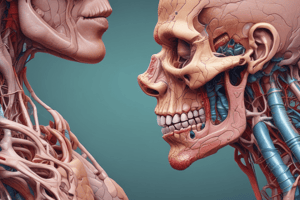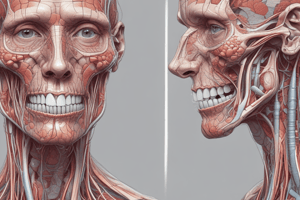Podcast
Questions and Answers
What is a fluid cyst formed due to saliva leaking from an injured gland called?
What is a fluid cyst formed due to saliva leaking from an injured gland called?
- Ranula (correct)
- Hydrocele
- Abscess
- Cystic fibrosis
Where does the saliva leak to in the case of a ranula?
Where does the saliva leak to in the case of a ranula?
- Into the bloodstream
- Into tissues next to the gland (correct)
- Into the lymphatic system
- Through the skin
What causes the formation of a ranula?
What causes the formation of a ranula?
- Blockage of the duct
- Injury to the gland (correct)
- Infection of the gland
- Overproduction of saliva
What is the primary component involved in the formation of a ranula?
What is the primary component involved in the formation of a ranula?
What is the location of a ranula relative to the gland?
What is the location of a ranula relative to the gland?
What are the two main types of salivary glands?
What are the two main types of salivary glands?
Which type of salivary glands produce most of the saliva in the mouth?
Which type of salivary glands produce most of the saliva in the mouth?
Which statement is true about major salivary glands?
Which statement is true about major salivary glands?
Which of the following are considered minor salivary glands?
Which of the following are considered minor salivary glands?
What is a key function of the major salivary glands?
What is a key function of the major salivary glands?
What is the term for inflammation of the submandibular gland?
What is the term for inflammation of the submandibular gland?
Which of the following accurately describes the nature of Sialadenitis?
Which of the following accurately describes the nature of Sialadenitis?
What percentage of submandibular stones are not visible on standard x-rays?
What percentage of submandibular stones are not visible on standard x-rays?
How can submandibular stones be identified if they are not visible on x-ray?
How can submandibular stones be identified if they are not visible on x-ray?
Which type of imaging is effective in identifying submandibular stones that are not detected by x-ray?
Which type of imaging is effective in identifying submandibular stones that are not detected by x-ray?
What is the role of saliva drainage in the context of discomfort and swelling?
What is the role of saliva drainage in the context of discomfort and swelling?
What symptom is associated with inflammatory disorders of the submandibular gland?
What symptom is associated with inflammatory disorders of the submandibular gland?
How long do symptoms typically persist before resolving in inflammatory cases?
How long do symptoms typically persist before resolving in inflammatory cases?
What anatomical feature separates the deep and superficial lobes of the parotid gland?
What anatomical feature separates the deep and superficial lobes of the parotid gland?
What symptoms may patients present with that are associated with painful sensations?
What symptoms may patients present with that are associated with painful sensations?
Which glands are primarily affected by inflammatory disorders mentioned?
Which glands are primarily affected by inflammatory disorders mentioned?
Which condition is associated with dry eyes in patients?
Which condition is associated with dry eyes in patients?
What are the mucosal areas that may show ulcerations in patients?
What are the mucosal areas that may show ulcerations in patients?
What feeling might patients experience alongside dry eyes?
What feeling might patients experience alongside dry eyes?
Which of the following pairs of symptoms are characteristically linked?
Which of the following pairs of symptoms are characteristically linked?
What is a characteristic appearance of Sjögren’s Syndrome observed in sialography?
What is a characteristic appearance of Sjögren’s Syndrome observed in sialography?
Which symptom is NOT associated with primary Sjögren’s Syndrome?
Which symptom is NOT associated with primary Sjögren’s Syndrome?
Frey’s Syndrome commonly occurs due to surgery in which area?
Frey’s Syndrome commonly occurs due to surgery in which area?
What causes the sweating and flushing in Frey’s Syndrome?
What causes the sweating and flushing in Frey’s Syndrome?
Secondary Sjögren’s Syndrome may be associated with which of the following diseases?
Secondary Sjögren’s Syndrome may be associated with which of the following diseases?
Which term is used to describe the visual appearance of the salivary duct abnormalities in Sjögren’s Syndrome?
Which term is used to describe the visual appearance of the salivary duct abnormalities in Sjögren’s Syndrome?
What is the primary imaging technique used to demonstrate defects in Sjögren’s Syndrome?
What is the primary imaging technique used to demonstrate defects in Sjögren’s Syndrome?
Which structure is associated with Frey’s Syndrome?
Which structure is associated with Frey’s Syndrome?
In which situation might Frey’s Syndrome develop?
In which situation might Frey’s Syndrome develop?
Which autoimmune condition is often linked to secondary Sjögren's Syndrome?
Which autoimmune condition is often linked to secondary Sjögren's Syndrome?
Flashcards
Major salivary glands
Major salivary glands
The largest and most important salivary glands that produce most of the saliva in the mouth.
Salivary glands
Salivary glands
Glands in the mouth that produce saliva.
Saliva production
Saliva production
The act of creating saliva by salivary glands.
Importance of Major Salivary Glands
Importance of Major Salivary Glands
Signup and view all the flashcards
Minor salivary glands
Minor salivary glands
Signup and view all the flashcards
Submandibular gland inflammation
Submandibular gland inflammation
Signup and view all the flashcards
Sialadenitis
Sialadenitis
Signup and view all the flashcards
Acute sialadenitis
Acute sialadenitis
Signup and view all the flashcards
Chronic sialadenitis
Chronic sialadenitis
Signup and view all the flashcards
Submandibular stones
Submandibular stones
Signup and view all the flashcards
Ranula
Ranula
Signup and view all the flashcards
What causes a ranula?
What causes a ranula?
Signup and view all the flashcards
Where does a ranula form?
Where does a ranula form?
Signup and view all the flashcards
What is the role of saliva?
What is the role of saliva?
Signup and view all the flashcards
Damaged salivary gland
Damaged salivary gland
Signup and view all the flashcards
What are parotid glands?
What are parotid glands?
Signup and view all the flashcards
Parotid gland lobes
Parotid gland lobes
Signup and view all the flashcards
Facial nerve and parotid gland
Facial nerve and parotid gland
Signup and view all the flashcards
Submandibular gland inflammation duration
Submandibular gland inflammation duration
Signup and view all the flashcards
Xerostomia
Xerostomia
Signup and view all the flashcards
Dry Eyes
Dry Eyes
Signup and view all the flashcards
Burning Sensation
Burning Sensation
Signup and view all the flashcards
Ulceration
Ulceration
Signup and view all the flashcards
Oral/Conjunctival Mucosa
Oral/Conjunctival Mucosa
Signup and view all the flashcards
Sjogren's Syndrome
Sjogren's Syndrome
Signup and view all the flashcards
Primary Sjögren's Syndrome
Primary Sjögren's Syndrome
Signup and view all the flashcards
Secondary Sjögren's Syndrome
Secondary Sjögren's Syndrome
Signup and view all the flashcards
Sialography
Sialography
Signup and view all the flashcards
Sialography Appearance
Sialography Appearance
Signup and view all the flashcards
Frey's Syndrome
Frey's Syndrome
Signup and view all the flashcards
Auriculotemporal Nerve
Auriculotemporal Nerve
Signup and view all the flashcards
Causes of Frey's Syndrome
Causes of Frey's Syndrome
Signup and view all the flashcards
Gustatory Sweating
Gustatory Sweating
Signup and view all the flashcards
Sjogren's Syndrome Biopsy
Sjogren's Syndrome Biopsy
Signup and view all the flashcards
Study Notes
Salivary Glands
- Salivary glands are exocrine glands that produce saliva through a system of ducts.
- Two types of salivary glands exist: major and minor.
- Major salivary glands are the largest and most important, producing most saliva in the mouth.
- Three major salivary glands: submandibular glands, parotid glands, and sublingual glands.
- Sublingual glands are paired, located in the anterior part of the mouth floor. Each has numerous excretory ducts opening into the oral cavity.
Disorders of Sublingual Glands
- Ranula: a mucous retention cyst that can arise from the sublingual salivary gland, forming under the tongue and filled with saliva leaked from a damaged salivary gland.
- Causes of ranula: saliva is unable to drain directly into the mouth if the sublingual gland is injured or diseased. Saliva leaks into surrounding tissues, forming a ranula.
- Presentation: painless swelling in the submandibular or submental region of the neck.
Submandibular Glands
- Paired salivary glands located below the mandible (jawbone) on each side.
- 8% of all salivary stones occur in submandibular glands because their secretions are highly viscous.
- 8% of submandibular stones are radio-opaque and can be identified on plain radiography.
- Common causes of submandibular gland inflammation (sialadenitis): viral (paramyxovirus) and bacterial. Bacterial is more common and secondary to obstruction.
- Common cause of obstruction: stone formation within the gland and its associated duct system
Clinical Symptoms of Sialadenitis
- Patients typically present with acute painful swelling in the submandibular gland area.
- Swelling often occurs rapidly after eating and resolves spontaneously within 1-2 hours.
- Clinical examination reveals enlarged, firm, and tender submandibular glands. Pus may drain from the sublingual papilla.
- Partial or complete obstruction of the submandibular duct is often involved. Stones are a frequent cause.
Parotid Glands
- The parotid gland is divided into deep and superficial lobes, separated by the facial nerve.
- Mumps is the most common cause of acute painful parotid swelling in children, spread via airborne droplets of infected saliva.
- Mumps typically starts with fever, nausea, headache, followed by pain and swelling in one or both parotid glands. Pain can be severe and exacerbated by eating or drinking.
- One episode of infection confers lifelong immunity.
Sjogren's Syndrome
- Unknown etiology, but genetic, hormonal, infectious, and immunologic factors may be involved. Immunologic mechanisms are a primary factor.
- Clinically, predominately affects women over 40, with a female-to-male ratio of 10:1.
- Commonly presents with dry eyes and dry mouth due to hypofunction of lacrimal and salivary glands, resulting in pain, burning sensations, and ulcerations on the oral/conjunctival mucosa.
- Sialography demonstrates cavitary defects filled with radiopaque contrast media, exhibiting a "branchless fruit laden tree" or "cherry blossom" appearance. Sjogren's involves biopsy
Frey's Syndrome (Gustatory Sweating)
- A condition characterized by sweating and sometimes flushing of the skin in the area of distribution of the auriculotemporal nerve.
- Thought to result from damage to the auriculotemporal nerve, where postganglionic parasympathetic fibers from the otic ganglion unite with sympathetic fibers from the superior cervical ganglion to supply sweat glands in the skin.
- The syndrome can occur after surgery of the parotid gland, TM joint, injuries to the face region, or injections into this area.
- Treatment for persistent cases may involve botulinum type A injections.
Studying That Suits You
Use AI to generate personalized quizzes and flashcards to suit your learning preferences.




